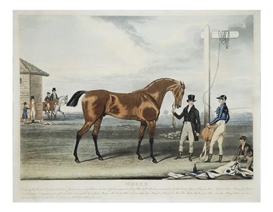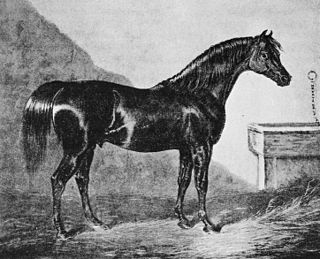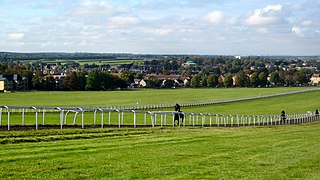
Whalebone was a British Thoroughbred racehorse that won the 1810 Epsom Derby and was a successful sire of racehorses and broodmares in the 1820s. Whalebone and his full-brother Whisker were produced by the prolific and important broodmare Penelope, and they contributed to the perpetuation of the genetic line (tail-male) of their sire Waxy and grandsire Eclipse into the 20th century. Whalebone raced until he was six years old and was retired to stud at Petworth in 1815. Whalebone sired the Derby winners Lap-dog, Spaniel and may have been the sire of Moses. Other notable sons are Sir Hercules and Camel, the sire of Touchstone. Whalebone died in 1831 at the age of 24 of hemorrhage after covering a mare.

Moses was a British Thoroughbred racehorse and sire. In a career that lasted from April 1822 to May 1823 he ran five times and won four races. In 1822, when three years old, he won all three of his races and became the second of six colts owned by members of the British Royal Family to win The Derby. His subsequent career was restricted by injuries and he was retired after sustaining his only defeat. He had limited success as a sire of winners and was exported to Germany in 1830.

Phantom was a British Thoroughbred racehorse and sire. In a career that lasted from April 1811 to April 1813 he ran ten times and won seven races. In the summer of 1811 he proved himself one of the best British colts of his generation, winning the Derby on his second racecourse appearance. He continued to race with considerable success for two more years, mainly in match races. He was retired to stud in 1814 and became a successful sire of winners before being exported to Mecklenburg in 1832.
Azor was a British Thoroughbred racehorse. In a career that lasted from April to October 1817 he ran five times and won two races. In the summer of 1817 he created a 50/1 upset by winning The Derby after being entered in the race to act as a pacemaker for a more highly regarded stable companion. The rest of his form was well below top class, with his only other success coming when he was allowed to walk over at Newmarket.
Pan was a British Thoroughbred racehorse and sire. In a career that lasted from June 1808 to July 1814 he had six different owners, ran twenty times and won nine races. His most important success came on his only appearance as a three-year-old in 1808 when he won the Derby as a 25/1 outsider. Pan won another eight races over the next four seasons, running mainly in match races at Newmarket. He raced for two more years without success before being retired as a nine-year-old in 1814.

Sam was a British Thoroughbred racehorse and sire. In a career that lasted from April 1818 to May 1819 he ran nine times and won three races. In May 1818 he defeated fifteen opponents to record his most important win in The Derby. His only other wins came in a walkover and a match race. After running without success as a four-year-old, Sam was retired to stud but made no impact as a sire of winners.
Paris was a British Thoroughbred racehorse. In a career that lasted from April 1806 to April 1808, he ran fourteen times and won seven races. In 1806 he won the Derby on his third racecourse appearance shortly after being sold by his breeder. Paris stayed in training for two more years and had some success in match races. His racing career was ended by an injury at Newmarket Racecourse in 1808, after which he was retired to stud where he proved a to be a complete failure.
Rhadamanthus was a British Thoroughbred racehorse and sire. In a career that lasted from April 1790 to 1793 he ran nine times and won five races. In the summer of 1790 he proved himself one of the best British colts of his generation, winning The Derby while still undefeated. He raced until the age of six, winning three further races. All of his runs apart from the Derby were at Newmarket.
Ditto was a British Thoroughbred racehorse and sire. During a racing career that lasted from May 1803 to April 1807 he was lightly campaigned, running six times in five seasons and winning four races. In the summer of 1803 he proved himself one of the best British colts of his generation, by winning Derby on his only appearance on the season. He went on to win two important races at Newmarket and a King's Plate at Guildford. Ditto was retired to stud in 1808 and had some success as a sire of winners.
Selim was a British Thoroughbred racehorse. He was owned by the Prince of Wales, D. Radcliffe and later Arthur Shakespear. After retiring from racing he became a successful stallion and was British Champion sire in 1814. His progeny included Azor, Medora, Sultan and Turquoise.

Prunella was a British Thoroughbred racehorse. Raced from 1791 to 1794, she won three races including a Sweepstakes of 200 guineas each at Newmarket. She was retired to stud and became an influential broodmare, foaling Epsom Derby winner Pope and Epsom Oaks winner Pelisse. Her daughters also went on to become top broodmares in their own right. She was owned by Augustus FitzRoy, 3rd Duke of Grafton.
Rubens was a British Thoroughbred racehorse. During his career he won three races, including the Craven Stakes in 1810. After retiring from racing he became a successful stallion and was the leading sire in Great Britain and Ireland in 1815, 1821 and 1822. His progeny included Landscape, Pastille, Whizgig and the Rubens mare.
The Alexander mare was an unnamed British Thoroughbred broodmare. She never raced, but at stud she foaled Castrel, Selim, Bronze and Rubens. Both Selim and Rubens became Champion sire in Britain.

Nike was a British Thoroughbred racehorse. She won three of her five starts, including the Oaks Stakes in 1797. She was owned Richard Grosvenor, 1st Earl Grosvenor, and later became a broodmare, with three of her foals placing in Classic races.

Pope Joan was a British Thoroughbred racehorse. She won four of her eight starts before being retired to stud, where she became a successful broodmare. She foaled 1000 Guineas winner Tontine, 2000 Guineas winner Turcoman and Epsom Oaks winner Turquoise. Pope Joan was bred by Augustus FitzRoy, 3rd Duke of Grafton and after his death was owned by his son George FitzRoy, 4th Duke of Grafton.

Filho da Puta was a British Thoroughbred racehorse. He won nine of his 12 races including the St. Leger Stakes and Doncaster Gold Cup. He also sired St. Leger winner Birmingham and was the leading sire in Great Britain and Ireland in 1828. He was owned by Sir William Maxwell and later T. Houldsworth. His name means "son of a bitch" in Portuguese.

Penelope (1798–1824) was a British Thoroughbred racehorse. She won sixteen of her twenty-four races, including two Oatlands Stakes, the Jockey-Club Plate and she beat Oaks and Derby winner Eleanor. She was bred and owned by Augustus FitzRoy, 3rd Duke of Grafton. After retiring from racing she became an influential broodmare, foaling Derby winners Whalebone and Whisker and 1000 Guineas winner Whizgig.
Camel was a British Thoroughbred racehorse. He won five of his seven races, including the Port Stakes in 1825, but his appearances were limited by leg problems. Throughout his racing career he was owned by Charles Wyndham. After retiring from racing Camel became a successful stallion, siring St. Leger winners Touchstone and Launcelot and becoming British Champion sire in 1838.

Parasol (1800–1826) was a British Thoroughbred racehorse. In total she won twenty of her thirty-five races, including two Newmarket First October King's Plates, the Jockey-Club Plate and a match race against Derby winner Cardinal Beaufort. Her only race away from Newmarket was for her début, in the Oaks Stakes in 1803. She was bred and owned by Augustus FitzRoy, 3rd Duke of Grafton. As a broodmare she foaled the stallion Partisan, 2000 Guineas winner Pindarrie and Pastille, who won both the 2000 Guineas and the Oaks.

Walton was a British Thoroughbred racehorse. He raced until he was eight years old, winning sixteen of his twenty five races. His first race was in 1802, with his first big win, the Third Class of the Oatlands Stakes, coming in 1803. He went on to win eight King's Plates and recorded wins over several leading racehorses of the time. He was owned by Sir Hedworth Williamson throughout his racing career. Walton later became a successful stallion and was champion sire of Great Britain twice. He sired the Derby winner Phantom, 2000 Guineas winner Nectar and St. Leger winner St Patrick.





















